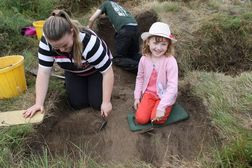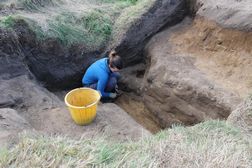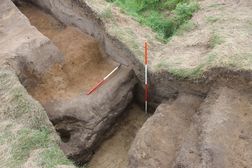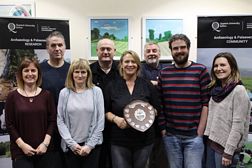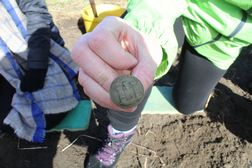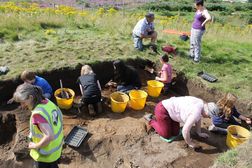Ballykinler
In 2016, as part of her doctoral studies, Dr Heather Montgomery along with the CAF and in partnership with the Department of Communities Northern Ireland and the Defence Infastructure Organisation excavated at Ballykinler, Co. Down. This landscape was the primary training ground for the 36th Ulster Division during the First World War, with many of the men going on to fight at the Battle of the Somme in 1916. The key objectives of Heather's research was to increase knowledge of the features within the current archaeologically protected (scheduled) areas within the modern military landscape, and to provide a more accurate interpretation of the physical remains of ‘training for war’ on the campus. This also involved archaeological excavation at the training trenches, work which revealed new insights into the training regime at Ballykinler.
Perhaps one of the most significant findings came from a ‘bunker area’ located just off the communication trench behind a practice frontline. The team discovered that original sandbag revetment had been preserved in the sandy soil for the past 100 years, giving us a very clear picture of the different ways the British Army had both used and developed this area to train throughout the course of the war. Starting as a simple ‘slot trench’ which was then widened and modified. A set of steps were cut into the sandy soil and a dugout constructed to facilitate a machine gun position within the trench system. Previously, it was believed by some that the men of the Irish Divisions raised in Ireland were sent into battle with little or no training, effectively unaware of what they might face on reaching the battle front. The excavation findings suggest that the training provided to the Irish regiments was in fact professional, relevant and based on lessons learned at the Front.
In March 2019 the CAF returned to Ballykinler and to carried out an excavation commissioned by the Ministry of Defence and supported by 591 Squadron of the Royal Engineers, Bangor. This area of sand dunes has long been known to be rich in archaeological remains with Collins’s 1950s excavations in the Dundrum sandhills uncovering ring ditches, burial cists and large collections of Neolithic and Bronze Age pottery and flint. Given the known archaeology of the immediate surrounding landscape the MoD were keen to find out more about an enigmatic circular ditched earthwork located at Ballykinler, overlooking the mouth of Dundrum Inner Bay. This earthwork has been linked locally to the Saga of Fergus mac Léti, a king of Ulster who reputedly fought with a sea monster and died on the shores of the bay.
The excavation was led by Sarah Gormley and Heather Dr Montgomery. The the team identified a First World War practice low command redoubt, a feature which when constructed on the battlefield would be designed to be held by a garrison of men for extended periods of resistance. This is a rare training feature and the first low command redoubt to be excavated in Ireland. They also uncovered the ruin of a dwelling which was last occupied by the Redmond family in the early 20th century.
The work at Ballykinler now provides a foundation for the further study of the training of Irish soldiers in the British Army during the First World War. Further survey work and archaeological excavation is required at other sites such as Magilligan, County Londonderry, and those in the republic of Ireland including Finner, County Donegal, and Kilworth, County Cork. The fieldwork has also provided information that can now be used to help manage and protect the site. The archaeologists who took part in the excavation developed a greater understanding of the physical reality of ‘Training for War’, consequently shedding light on the experiences of the soldiers who trained at Ballykinler during the First World War.
During the 2019 dig the team were joined by over 70 school children from Braniel Primary School, New-Bridge Integrated College, Shimna Integrated College and Campbell College who all took part in the excavation in very windy conditions thanks to Storm Gareth! The team are grateful to Major Canniford for creating the opportunity to explore such great archaeology in a terrific setting and to all those who have participated in the work so far, including our superb volunteers John and Frank.

